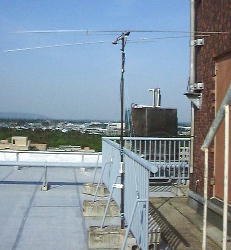Receiving Stations (using devices)
At receiving station, we receive radio wave from transmitting station using antenna and receiver. Then, the sound output from receiver send to computer LINE-IN. Then, this signal is analyzed by observing software “HROFFT" with FFT. On the screen, we can see the FFT results with spectrum of intensity.The sample image is as following. The horizontal axis means time scale. The FFT is done every 0.5second. The vertical axis means the frequency. Since the ionized trail is distributed after meteor appears, we can see the Doppler shift. As very important thing, this doppler shift does not mean meteor doppler. The meteor doppler is called head echo. The doppler shift of head echo is much wider than doppler shift of distribution of ionized trail.
Receiver

In Japan, the most famous frequency is 53.750MHz. In 2000, Mr. Kazuhiko Ohkawa therefore developed the receiver at 53.750MHz only. (If you configure at your using frequency, you can use this receiver.) Since this receiver is used at only 53.750MHz, the cost is too inexpensive which is about 9,800YEN (about 90US$). The overview of this receiver is as right picture. This receiver was provided ITEC corporation. Since it is too inexpensive to get this receiver, many observers started Radio Meteor Observation in Japan.
Antenna

Since Japan is very small contry and transmitting power is 50W, Many Japanese observers use HB9CV 2el. antenna. The antenna image is as right picture. The antenna direction depends on the distance between transmitting and receiving stations and also deceide observing conditions around receiving station. Many observers located in less than 200km, the antenna is turned to the zenith. In over 200km observing area, some observers turn to the zenith and some observers turn to the horizon.
Analysis
The counting is very important work for analyzing meteor shower activity. We count the number of meteor echoes and report to worldwide network. Japanese observers report to The International Project for Radio Meteor Observation, and this project reports to RMOB. The number of observing stations increase and many observing stations are monitoring meteor activity at all times. The counting method is written in this page. Please see this page.